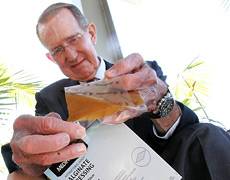Manuka honey pilgrim meets his benefactors
NZ Herald 4:00AM Wednesday Apr 15, 2009
Tom Lloyd hails a manuka-soaked bandage, made by
Comvita, for helping to save his leg.
As the cruise liner Millennium pulled into port at Tauranga, the
sense of anticipation built in passenger Tom Lloyd – not
because he was excited to see the sights of the Bay, but
because the American was finally going to meet the people
who changed his life.
Mr Lloyd made a beeline for Paengaroa – and Comvita – to meet the makers of the manuka honey dressings he credits with saving his leg from amputation.
The successful treatment of a rare infection – one only 27 people are recorded as having – gained attention worldwide after New York doctors used manuka bandages when other traditional treatments failed.
The kidney-transplant recipient got the infection in his right leg just days before Christmas in 2007. With a weakened immune system and the aggressive antibiotic treatment not working, the infection spread to his spinal fluid and the situation looked grim.
Doctors were able to stop the spread of the yeast infection without the need for kidney dialysis – but a sore on his leg refused to heal.
“It was swollen, yellow and green. It was like an open sore from my ankle to my knee,” he said.
“If you see the pictures, you’ll wonder how the leg even survived.”
The 68-year-old was told doctors would have to either amputate the leg or cut out the dead skin and replace it with flesh from another part of his body.
That was until a nurse suggested trying MediHoney, a manuka-soaked bandage made of seaweed that had just been approved by the US Food and Drug Administration.
“I thought great, let’s try anything,” he said.
Within two weeks, the natural remedy had done something traditional medicines had been unable to do over two months.
So, when he and wife Sally booked a two-week cruise around Australia and New Zealand, Mr Lloyd noticed that the stop in Tauranga offered a tour of Comvita.
“I knew it [manuka honey] was a New Zealand product and when I saw we were going to be in the area of Comvita, I called the wound-care nurse,” he said.
Comvita chief executive Brett Hewlett was excited at the prospect of meeting the man behind the miraculous story.
He took Mr Lloyd for an exclusive tour of the Comvita head office in Paengaroa and detailed how special the manuka honey used was.
From the very source, the beehives are positioned to avoid contamination. Once collected, the honey is treated with gamma radiation.
“It would be a very expensive honey to put on your toast,” Mr Hewlett said,
“but those dressings are edible.”
The healing properties of the honey have long been known by Maori, but now the product is increasingly in use in hospitals around New Zealand and overseas.
(Thank you to Rachel Elliot for sending us this article)
